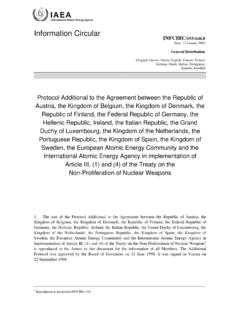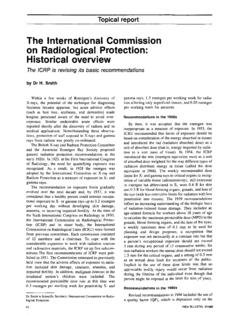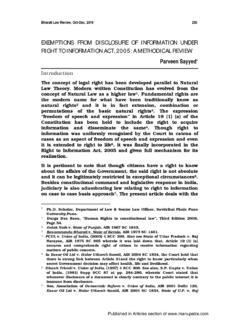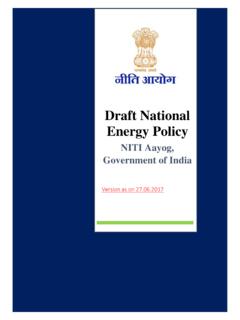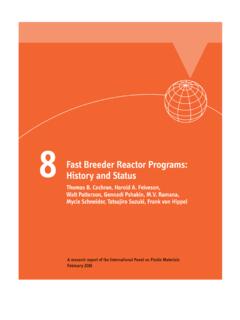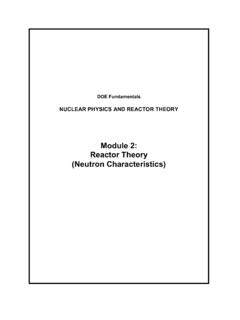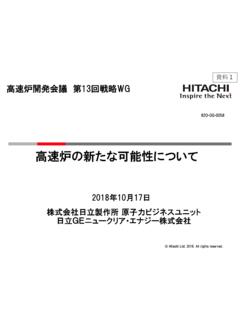Transcription of Review of the Environmental Impact of Nuclear Energy
1 Review of theEnvironmental Impact ofNuclear Energyby Essam E. El-HinnawiEnergy has long been viewed as an essential ingredient in meeting man's basic needs and instimulating and supporting economic growth and the standard of living, so much so thatoften a nation identifies its wellbeing with its gargantuan and growing need for data on Energy consumption of the world in recent years [1] show that worldconsumption has increased by about 50% in less than ten years. It has been estimated thatthe per capita use of Energy has more or less doubled during the past 30 years, and currenttrends indicate that consumption will grow at a faster rate in the future. This increase is anatural result of growing socio-economic activities and the rising standard of increasing global demand for Energy has hitherto been met to an increasing extent bythe use of fossil fuels and hydro power. Nuclear Energy has been developed and usedcommercially for about two decades to meet a fraction of the electrical Energy total installed Nuclear generating capacity in the world in 1976 was GWe from187 power reactors operating in 19 countries [2].
2 Table I summarizes that most recent estimates of possible Nuclear generating capacity at theturn of the century. The estimates demonstrate the wide range of possibilities, which iswider after 1985, because of possible changes in rates of growth of economic activity and avariety of other considerations that may affect the rate of commissioning of Nuclear powerstations. Using the IAEA estimates, Nuclear Energy will contribute about 11 13% of thetotal electricity generating capacity in the world in 1985 and about 17 20% in the year the local and in some cases regional level, the Environmental aspects of Energy productionand use have become of paramount importance and have served as warnings of what could bein store on a wider scale if serious consideration is not given to the environmentalimplications of man's demands for Energy . From recent examinations of the Impact of energyon the environment, it has become apparent that individual nations are not isolated in thisrespect and that the actions of one country may well result in Environmental damage in aneighbouring State.
3 Against this background, an awakened public awareness of the issues hasdemanded that an attempt be made to examine rationally the Environmental aspects of theenergy-related society. Although Nuclear power stations do not emit fly-ash or noxiousgases into the atmosphere as fossil-fuel-operated plants do, the radioactivity released fromthe products of Nuclear fission has been the main focus of public concern about the expansionin the use of Nuclear power despite the stringent control measures and precautions takenThere have been many attempts to set up acceptable levels for radioactivity in the environ-ment or in man, and although the ICRP recommendations are generally accepted inevaluating occupational hazards, their extension to large populations and the environmentas a whole has been subjected to extensive El-Hmnawi is Senior Officer, Policy Planning, United Nations Environment Programme, Nairobi32 IAEA , IMPACTS OF THE Nuclear FUEL CYCLET oday.
4 The dominant reactor type uses enriched uranium-oxide fuel, and is moderated andcooled by water. The water may generate steam directly in the reactor (BWR) or maytransfer its heat to an external steam generator (PWR). Besides these light-water reactors(LWR), other types based mostly on the use of graphite of D2O as moderator have beendeveloped. Experimental or prototype systems include the plutonium recycle reactor, wherePlutonium makes up part or all of the fuel, and the fast breeder reactor (e g LMFBR),where the fuel is a mixture of plutonium oxide and natural or depleted uranium oxideThe latter type of reactor is designed to produce more fissile material, usable as reactor fuel,than it consumesThe ' Nuclear fuel cycle' refers to the entire programme from the mining and milling ofuranium, through the manufacture of fuel elements for the reactor, transport and reprocessingof irradiated fuel, to the management of wastes produced in all steps of the cycle Theenvironmental impacts associated with all these steps are reviewed in this mining and millingThe uranium production in 1975 was about 26 000 tonnes and will, it is estimated, reach40 000 tonnes in 1980 [4, 6 8] Current projections show that demand for low-costuranium fuel will surpass uranium production capacity by 1985.
5 The cumulative uraniumrequirements are estimated to be about 0 8 1 million tonnes in 1990 and 2-3 milliontonnes by the year 2000 [6, 8] There is at present no consensus as to whether low-costuranium to this amount actually physically exists in the uppermost part of the earth's crustfrom which it could be economically produced. In any case accelerated efforts for theexploration and exploitation of new resources to meet the projected increasing demands ofthe Nuclear industry seem inevitable [6, 9].1 Uranium ores are mined by underground, surface or solution mining depending on thegeological setting of the ore. For a 1000-MWe Nuclear plant (LWR), about 50 000-80 000 tonnes of uranium ore (0 2% U content) are required. Over the lifetime of a plant,about 30 years, the figure will be about 1 5 million tonnes This corresponds to the needfor mining about 1000 acre-feet of uranium ore as compared to about 50 000 acre-feet of coalfor a coal-fired plant of the same capacity [10] 2 Table I.
6 Estimates of Nuclear generating capacity (GWe) for the years 1985 and 2000 Year19852000 OECD [3]538-7002800-4100 OECD-NEA/IAEA[4]479-5302005-2480 USERDA[5]390-4881695-2250 IAEA [6]350-4001500-18001 The situation is similar in the case of other metals used in the Nuclear industry (e g zirconium, boron,cadmium, graphite) Appropriate management of these resources is needed to satisfy the increasing needsof the Nuclear and other industries2 An acre-foot is the volume of liquid or solid required to cover one acre to a depth of one footOne acre = 4 047 X 103 m2 , one foot = 3 048 X 10"1 mIAEA , NO 2 33 The Environmental impacts associated with uranium mining can be classified into Impact onland and water (through spoil and waste water arising from mine drainage and/or from waterused in drilling) and occupational health hazards Radon produced by the radioactive decayof 226Ra found in the ores has been considered a major factor in increasing the cancerincidence amoung uranium miners [11 14] Exposure is normally controlled by eithernatural or artificial ventilation and is kept within the permissible limits of radon concentrationControl of dust generated in the mining processes is also necessary to prevent exposure tohazardous levels of silica as well as radiationIt should be noted that the Environmental impacts and occupational hazards associated withcoal mining (to operate a 1000 MWe plant), tend to be more significant than those associatedwith uranium mining (to operate a plant with the same capacity).
7 Accidental mining fatalitiesper coal plant exceed those from Nuclear plant by a factor of three [15]. The number of' Environmental deaths' among coal miners (from pneumoconiosis) is much higher than in thecase of miners in the uranium industryIn the milling process, about 70% of the total radioactivity contained in the ore fed to themills remains undissolved in the solid mill tailings [16]. The Environmental effects oftailings piles include: wind erosion to unrestricted areas, river pollution from piles locatednear river banks, or from water level rising during flood conditions to the base of the pilescausing leaching of radium from the material and percolation of water through piles intogroundwater [17]. Studies [17-22] have shown that the tailings piles must be stabilizedagainst wind and water erosion for very long periods (dictated by the radioactive half-lifeof 1620 years for 226Ra).
8 Because of the radon emanations from the radium in the milltailings, this material should not be used either in structural materials or in backfill materialin connection with buildings intended for human occupation, and equally such buildingsshould not be constructed in the proximity of mill tailings pilesFuel fabricationThe main potential hazard in the fuel fabrication process arises from the toxicity ofhydrogen fluoride and fluorine used in the production of uranium hexafluonde. Safemethods of handling these chemicals are, however, well-established in the fluorochemicalindustry. The UF6 produced is a highly corrosive gas as passed through enrichment plants,but a solid at room temperature, and can be safely packaged in steel cylinders. It is at thepoint of discharge from the conversion operation as UF6 that material in the fuel cyclepasses into the Non-Prohferation Treaty safeguards system set up by the IAEA.
9 Underthese safeguards, Nuclear material in all subsequent operations of the cycle must be physicallyaccounted for with great the level of uranium enrichment increases, so too does the risk of accidental agglomerationof sufficient quantities of 23SU to set off a chain reaction. Although criticahty accidents arevery unlikely to occur, great care is needed to ensure that such events never occur. Thedepleted uranium residue from enrichment plants is normally stockpiled for possible futureuse as a fertile component of reactor fuel. This material is mildly radioactive, and graduallyproduces the much more hazardous nuclides 226Ra and 222Rn Production of these nuclidesis, however, very slow and any radiation hazard from the stockpiles is controlled by limitingaccess to the IAEA BULLETIN-VOL 20, production of uranium dioxide fuel elements is now a well-established procedure whichseems to be free of appreciable hazards.
10 Manufacture of mixed-oxide fuel is, however,much more complicated. Hazards arise from the toxicity of plutomum and from the factthat the 'critical mass' of plutomum dioxide in which chain fission reactions can start up isonly a few kilograms. However, normal operational hazards of mixed-oxide fuel productionare not difficult to operationDuring the normal operation of a Nuclear reactor, radioactive fission and activation productsare produced. These radioactive materials are for the most part retained within the fuelelements. Radionuclides which diffuse into or are formed within the cooland are removedby the gaseous and liquid waste-processing systems Low-level releases, which occur duringnormal operation, are closely regulated to ensure that authorized release limits are releases from reactors depend on the reactor type and on the specific waste-processing systems utilized. Radionuclides which diffuse into or are formed within thecoolant are removed by the gaseous and liquid waste-processing systems Low-level releases,which occur during normal operation, are closely regulated to ensure that authorized releaselimits are not releases from reactors depend on the reactor type and on the specific waste-processing systems utilized Radionuclides released in the airborne effluents consistessentially of.



